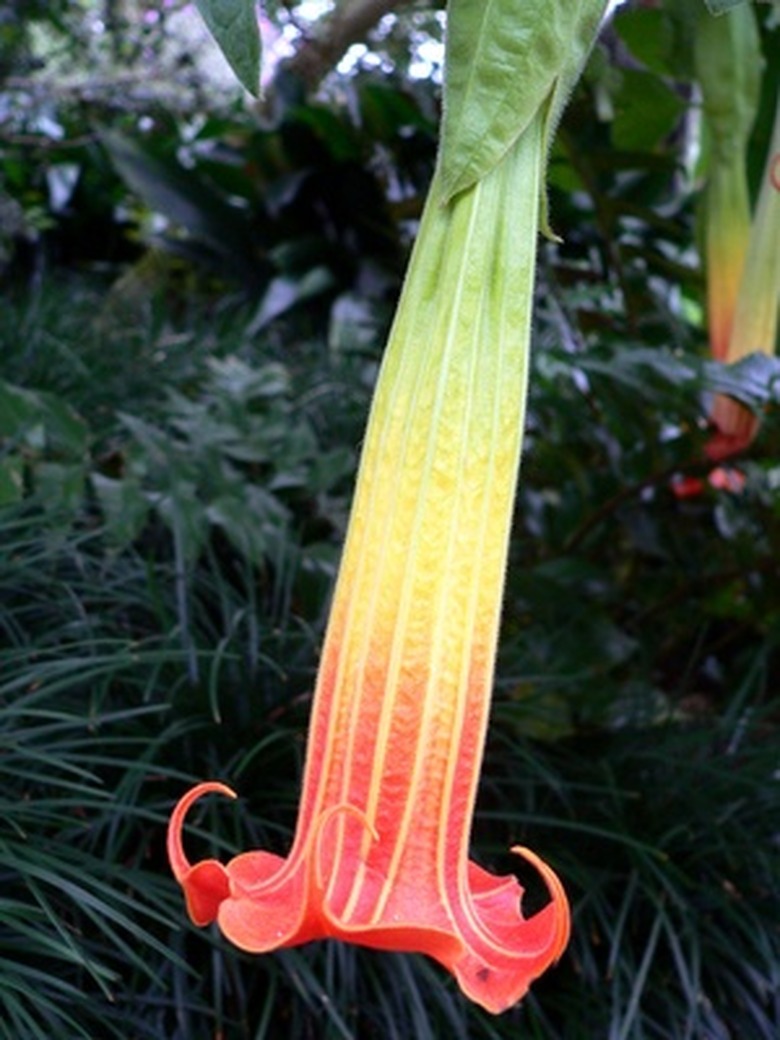Brugmansia Disease
Brugmansia, also called angel trumpet, is a large, flowering shrub that produces blooms that resemble big colorful trumpets. This shrub is not particularly susceptible to root diseases, which makes it a fairly hardy variety of blooming landscape plant, but it does have a number of other disease-related issues that can stunt your brugmansia or even kill it if you do not recognize and treat the symptoms when you spot them.
Function
Brugmansia diseases tend to affect the leaves and stems of the plant. They can infect the plant either because of poor growing conditions or from plant debris lying on the ground. In some cases, infections can be sourced back to insects. While most brugmansia diseases are not life-threatening on their own, they can weaken the plant over time, stunting growth, diminishing blooms and making the plants susceptible to other infections.
Infections Caused By Humidity
Brugmansia plants can tolerate levels of humidity of 50 percent or higher, according to Logee's Greenhouse, but levels of humidity that are too high can create some problematic infections for brugmansia. Powdery mildew and other forms of mold affect brugmansia bushes that do not get enough air circulation or sunlight and that have foliage that is so dense that it creates a very humid environment within the plant. Powdery mildew looks like a coating of chalk dust on the leaves, stems and flowers of brugmansia, and is black, gray, white or pinkish in color. Slime molds and other mildews tend to be black and have a smoother surface that may feel mushy to the touch.
- Brugmansia, also called angel trumpet, is a large, flowering shrub that produces blooms that resemble big colorful trumpets.
- Powdery mildew and other forms of mold affect brugmansia bushes that do not get enough air circulation or sunlight and that have foliage that is so dense that it creates a very humid environment within the plant.
Fungal Infections
If you notice your brugmansia has spots on its leaves, it likely has a fungal infection. These "leaf-spot" diseases can be caused by a variety of fungi and may cause the leaves to develop ever-widening spots in yellow, brown or purple, or may actually cause the tissue of the leaves to rot away. Most leaf-spot diseases are largely cosmetic, but they can weaken the plant and cause defoliation if you do not check the infection.
Insect Issues
Brugmansia are particularly susceptible to whiteflies and spider mites. These tiny insects can be spotted crawling on the undersides of leaves and often cause the plant to appear wilted, even when it is getting plenty of water. Spider mites leave small, webbed residues in the crooks of leaves and branches. Aphids and mealybugs may also present problems, and may be spotted because of wilting or because of the mold and mildew infections that often follow these honeydew-secreting insects.
- If you notice your brugmansia has spots on its leaves, it likely has a fungal infection.
- These "leaf-spot" diseases can be caused by a variety of fungi and may cause the leaves to develop ever-widening spots in yellow, brown or purple, or may actually cause the tissue of the leaves to rot away.
Prevention/Solution
Pruning the tree once a season will help prevent the formation of a dense, humid environment that fosters molds and mildews. Raking out plant debris from underneath the plant will help prevent fungal infections like leaf-spot diseases. You can usually keep most insects at bay with neem oil or an insecticidal soap. Plain liquid dish soap diluted and sprayed on the tops and bottoms of all leaves on your brugmansia will make it unpalatable for most insect pests. If your brugmansia is already showing signs of infection, remove all affected foliage. Dispose of the plant materials in a sealed plastic bag rather than dropping them on the ground. Rake away all plant debris from underneath the plant and dispose of it in a sealed bag as well. If mites or other insects are creating problems, remove any moldy foliage and spray the entire plant with diluted dish soap or an insecticide. Monitor your brugmansia carefully for signs of reinfection.
- Pruning the tree once a season will help prevent the formation of a dense, humid environment that fosters molds and mildews.
- If mites or other insects are creating problems, remove any moldy foliage and spray the entire plant with diluted dish soap or an insecticide.
